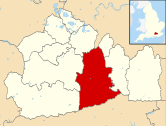
Salisbury Plain is a chalk plateau in the south western part of central southern England covering 300 square miles (780 km2). It is part of a system of chalk downlands throughout eastern and southern England formed by the rocks of the Chalk Group and largely lies within the county of Wiltshire, but stretches into Berkshire and Hampshire. The plain is famous for its rich archaeology, including Stonehenge, one of England's best known landmarks. Large areas are given over to military training and thus the sparsely populated plain is the biggest remaining area of calcareous grassland in northwest Europe. Additionally the plain has arable land, and a few small areas of beech trees and coniferous woodland. Its highest point is Easton Hill.
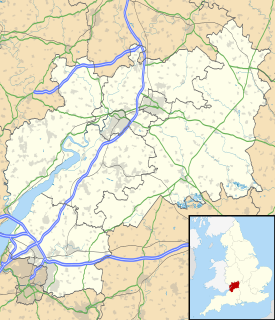
The Cotswold Water Park is the United Kingdom's largest marl lake system, straddling the Wiltshire–Gloucestershire border, northwest of Cricklade and south of Cirencester. The lakes were created in the second half of the 20th century by extraction of glacial Jurassic limestone gravel, which had eroded from the Cotswold Hills, and these filled naturally after working began to cease in the early 1970s.

Reed beds are natural habitats found in floodplains, waterlogged depressions, and estuaries. Reed beds are part of a succession from young reeds colonising open water or wet ground through a gradation of increasingly dry ground. As reed beds age, they build up a considerable litter layer that eventually rises above the water level and that ultimately provides opportunities for scrub or woodland invasion. Artificial reed beds are used to remove pollutants from grey water.

Windsor Hill is a 61.8 hectare biological Site of Special Scientific Interest in Princes Risborough in Buckinghamshire. It lies within the Chilterns Area of Outstanding Natural Beauty, and it is featured in the Nature Conservation Review. A small part is managed by the Berkshire, Buckinghamshire and Oxfordshire Wildlife Trust, and access to this area requires a permit.
Ashford Green Corridor is a green space that runs through the town of Ashford in Kent, England. The Green Corridor is made up of parks, recreation grounds and other green spaces alongside the rivers that flow through Ashford. It is a Local Nature Reserve.
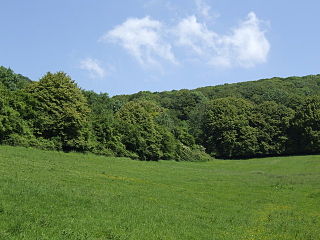
Cheddar Wood is an 86.9-hectare (215-acre) biological Site of Special Scientific Interest at Cheddar in the Mendip Hills, Somerset, England, notified in 1967.
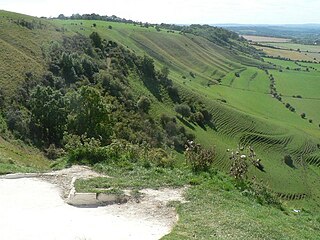
Bratton Downs is a 395.8 hectare biological and geological Site of Special Scientific Interest in Wiltshire, near the villages of Bratton, Edington and Westbury. It was notified in 1971. The designated area consists mainly of chalk grassland, as well as some ancient woodland, and supports a diverse range of native flora and fauna. It overlays notable geological features—principally landforms created by glaciation in the Pleistocene.

Bowerchalke Downs, is a 128.6 hectare biological Site of Special Scientific Interest in Wiltshire, notified in 1971. The downs encompass the entire southern outlook of the village of Bowerchalke in the Salisbury district of Wiltshire, England, and are adjacent to both the Hampshire and Dorset county boundaries. The Bowerchalke Downs are located within the Cranborne Chase and West Wiltshire Downs Area of Outstanding Natural Beauty and are part of the Southern England Chalk Formation.

Scotstown Moor is in the north of Aberdeen, Scotland.

Park Gate Down or Parkgate Down is a 7-hectare (17-acre) biological Site of Special Scientific Interest south-east of Stelling Minnis in Kent. It is also a Special Area of Conservation and is managed by the Kent Wildlife Trust,

The Turnford and Cheshunt Pits is a biological Site of Special Scientific Interest near Cheshunt in Hertfordshire and Essex and covers a total of 428.17 acres. It is part of the Lee Valley Special Protection Area.
Possil Marsh is a nature reserve and Site of Special Scientific Interest, of both flora and fauna, within the city of Glasgow, Scotland. The reserve was once part of an extensive system of lochs and marshes which extended throughout much of lowland West Central Scotland. However, centuries of drainage and reclamation have resulted in the elimination of much of this system. Due to its geographic position, the marsh is particularly vulnerable from industrial and residential development. The reserve contains a monument for the High Possil meteorite, which fell there in 1804.
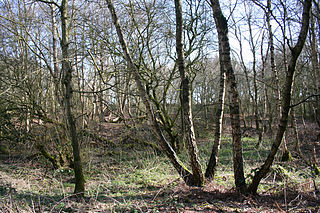
Sound Heath, also known as Sound Common, is an area of common land in Sound, near Nantwich in Cheshire, England, which includes heathland, grassland, scrub, woodland and wetland habitats. The majority of the area is designated a Site of Special Scientific Interest and a Local Nature Reserve.

Decoy Pit, Pools and Woods is a 17.7-hectare (44-acre) biological Site of Special Scientific Interest south of Aldermaston in Berkshire. An area of 8 hectares is a nature reserve called Decoy Heath, which is managed by the Berkshire, Buckinghamshire and Oxfordshire Wildlife Trust.

Scirpus ancistrochaetus is a rare species of flowering plant in the sedge family known by the common names barbedbristle bulrush and northeastern bulrush. It is native to the northeastern United States from New Hampshire south to Virginia. It used to be found in Quebec but it is now thought to be extirpated there. It was also believed extirpated from the state of New York, but at least one population has been rediscovered in Steuben County in 2010. It is threatened by the loss and degradation of its wetland habitat. It is a federally listed endangered species.

Upper Wye Gorge is a Site of Special Scientific Interest (SSSI), noted for its biological and geological characteristics, around Symonds Yat in the Upper Wye Valley on the Wales–England border. The site is listed in the 'Forest of Dean Local Plan Review' as a Key Wildlife Site (KWS).

Old River Severn, Upper Lode is a 3.72-hectare (9.2-acre) biological Site of Special Scientific Interest in Gloucestershire, notified in 1985. It is a cross county border site between Gloucestershire and Herefordshire and Worcestershire.
Briddlesford Nature Reserve consists of 158 hectares of land on the Isle of Wight that is composed of a complex of different habitats, including woodland, arable farmland, lowland meadow, parkland, pond, hedgerow and grazing marsh. The reserve encompasses a majority of the Briddlesford Copses Site of Special Scientific Interest (SSSI) and Special Area of Conservation (SAC) together with about 50 hectares of farmland. The reserve is owned by People's Trust for Endangered Species (PTES) and managed to preserve and enhance its biodiversity value.

Monawilkin is a townland in the West Fermanagh Scarplands in the Civil Parish of Inishmacsaint, Barony of Magheraboy, Northern Ireland. The townland has an area of 85.1947 hectares and has previously been referred to as Meenwilkin (1817) and Munadh Wilkin. Monawilkin is the best example of unimproved calcareous grassland in Northern Ireland. This differs from other Sesleria-dominated grasslands in the UK in that it also includes species such as Euphrasia salisburgensis (eyebright). Monawilikin is also an important orchid site, contains the best inland site for moths and butterflies in Northern Ireland, and is the only Northern Irish site for Cupido minimus, the small blue butterfly. Consequently, this area was designated as a special area of conservation (SAC) and area of special scientific interest (ASSI). The Monawilkin SAC land cover comprises 3% water bodies, 5% bogs, marshes, and fringe water vegetation, 13% heath and scrub, 50% dry grassland, 14% humid grassland, and 15% broad-leaved woodland.

Mar Field Fen is a Site of Special Scientific Interest, or SSSI, north of Masham, North Yorkshire, England, in a rural area known as Marfield. It is situated on land containing woodland carr, fen, spring-fed marshy grassland and drier calcareous grassland, between the River Ure to the east and Marfield Wetland nature reserve to the west. As "one of the best examples of fen habitat in the Vale of York," it is a protected habitat for a variety of plants, including the common butterwort, a carnivorous plant. There is no public access to this site.


















